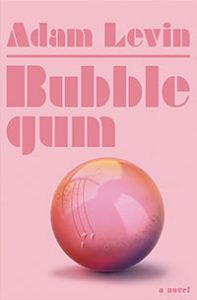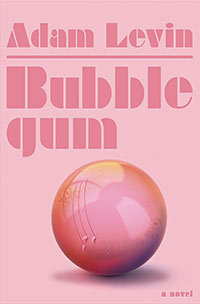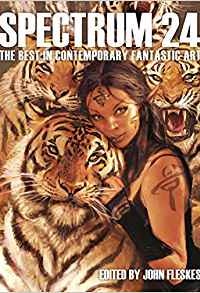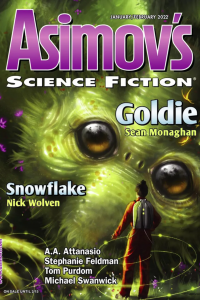Ian Mond Reviews Bubblegum by Adam Levin
 Bubblegum, Adam Levin (Doubleday Books 978-0-385-54496-2, $29.95, 784pp, hc) April 2020.
Bubblegum, Adam Levin (Doubleday Books 978-0-385-54496-2, $29.95, 784pp, hc) April 2020.
Back in 2010, as part of McSweeney’s now lapsed “Book Release Club,” I was sent a copy of The Instructions by debut author Adam Levin. Like everything published by McSweeney’s, the novel was a beautiful artefact, a bright red cover depicting multiple versions of a hooded boy reaching for a girl. It was also over 1,000 pages long, and while I’ve never been particularly intimidated by big books (I am, after all, a Stephen King fan), the idea of investing all that time on a literary novel – most likely dense with language and thin on plot – didn’t appeal to me. In the ten years since the publication of The Instructions, my tastes, particularly my appreciation of literary fiction, have matured. While my preference is for shorter novels (less than 80,000 words), with the help of David Foster Wallace, Eleanor Catton, and more recently Lucy Ellmann, I’ve come to recognise the pleasures of reading longer, weightier works where language and voice take precedence. I was therefore emotionally and intellectually prepared for Bubblegum, Adam Levin’s 800-page follow-up to The Instructions, a novel that brilliantly straddles that hazy no-man’s land between literary and genre fiction.
Bubblegum is the memoir of Belt Magnet, a 39-year-old unemployed writer with one (out-of-print) novel to his name, who lives with his father in the Chicago suburb of Wheelatine. His unique name isn’t the only thing that sets him apart from the few people he interacts with. In 1988, 12-year-old Belt gains notoriety amongst the kids in the neighbourhood and eventually the adults, for murdering 11 swingsets with a baseball bat, and, on one memorable occasion, with an axe. When Belt explains to the authorities that the swingsets had asked to be euthanised (and that he frequently spoke with inanimate objects, which he calls “inans”), Belt is diagnosed with a psychotic disorder. Several months later, Belt participates “in the now-(in) famous Graham&Swords Friends study” conducted by Doctor Manx, where he is assigned one of the first-ever “Botimals,” a manufactured pet born from a marble, that smells like bubblegum, is easy to clean, requires body-heat (hugs) to survive, and is “smarter than mogwais, and a thousand times as cute.” In a timeline where the internet is never invented, these interactive pets, released to the market as “Cures,” fill that technological void. Their popularity skyrockets when people discover that torturing them, forcing them to sing in pain, makes them so adorable, so intensely cute, that the only option is to bite their heads off – a practice that’s dubbed “overloading.” In the meantime, Belt, who still speaks to inans, and who spends his days smoking cigarettes, scribbling in his memoir, and teaching Blank (his Cure) new tricks, struggles to find purpose in a world driven insane by a disposable pet.
To spend 800 pages – and in my case 11 days – in the head of a man crippled with self-doubt and a deep, abiding fear of social interaction isn’t a reading experience I would actively seek out. And yet if Adam Levin had emailed me an additional 100,000 words of Belt’s circuitous ramblings, I would have carried on reading with nary a thought to the contrary. This is because, as Belt’s memoir toggles between 1988 and 2013, Levin does an astonishing job at varying the tone and pitch of the novel. The book is often incredibly funny. For example, a character flaw in Belt – “Something about me, something inadvertent and perhaps uncontrollable… [that] encourages others to monologize at me, especially those who I’ve only just met” – results in these loquacious, sometimes incoherent, always entertaining speeches from an assortment of animate and inanimate characters on topics as varied as the history of dynamite and the importance of owning a hanky. Humour, and a heightened sense of reality, from Belt’s association with “billionaire astronaut” Jonny “Jonboat” Pellmore-Jason, his child-prodigy son, Triple-J – a dab hand at video collages and a massive fan of Belt’s novel – and Jonboat’s wife Fondajane, “a staggeringly gorgeous intersex sex-worker-slash-wunderkind of critical theory” also abounds. In contrast to the laughs, the story can be emotionally devastating. The scenes where 12-year-old Belt watches his mother die in excruciating pain from a brain tumour had me choking back tears, while middle-age Belt’s struggle to find common ground with his well-meaning, if blunt and coarse father is particularly moving. Bubblegum is also a novel that trades heavily on cruelty and graphic violence. At one point, Belt is paid a large sum of cash to transcribe a DVD edited by Triple-J (as part of an art installation) which consists of 24 videos, each one dealing, in some manner, with the torture of a Cure. Reading through the transcript is harrowing and speaks partly to the question of what constitutes art but also to the animalistic thrill we get from violence, especially of the harmless and innocent. What ties all these intense emotions together is Belt’s relationship with Blank. Given that Cures barely survive a year before their owners “overload” on them, the fact that Belt has kept Blank alive for more than two decades – hiding his actual age from his father and others who would profit off the novelty of such an old Cure – is a testament to his capacity for love.
The irony that threads through Bubblegum is that the very technology Levin erases from his narrative, that has reduced our reality to a 30-second video or a 280-character tweet, may dissuade people from investing time in such a lengthy novel. But if you decide to take the dive, and I heartily suggest you do, reading Bubblegum is an experience you won’t soon forget.
Ian Mond loves to talk about books. For eight years he co-hosted a book podcast, The Writer and the Critic, with Kirstyn McDermott. Recently he has revived his blog, The Hysterical Hamster, and is again posting mostly vulgar reviews on an eclectic range of literary and genre novels. You can also follow Ian on Twitter (@Mondyboy) or contact him at mondyboy74@gmail.com.
This review and more like it in the April 2020 issue of Locus.
 While you are here, please take a moment to support Locus with a one-time or recurring donation. We rely on reader donations to keep the magazine and site going, and would like to keep the site paywall free, but WE NEED YOUR FINANCIAL SUPPORT to continue quality coverage of the science fiction and fantasy field.
While you are here, please take a moment to support Locus with a one-time or recurring donation. We rely on reader donations to keep the magazine and site going, and would like to keep the site paywall free, but WE NEED YOUR FINANCIAL SUPPORT to continue quality coverage of the science fiction and fantasy field.








